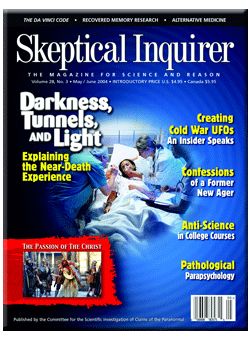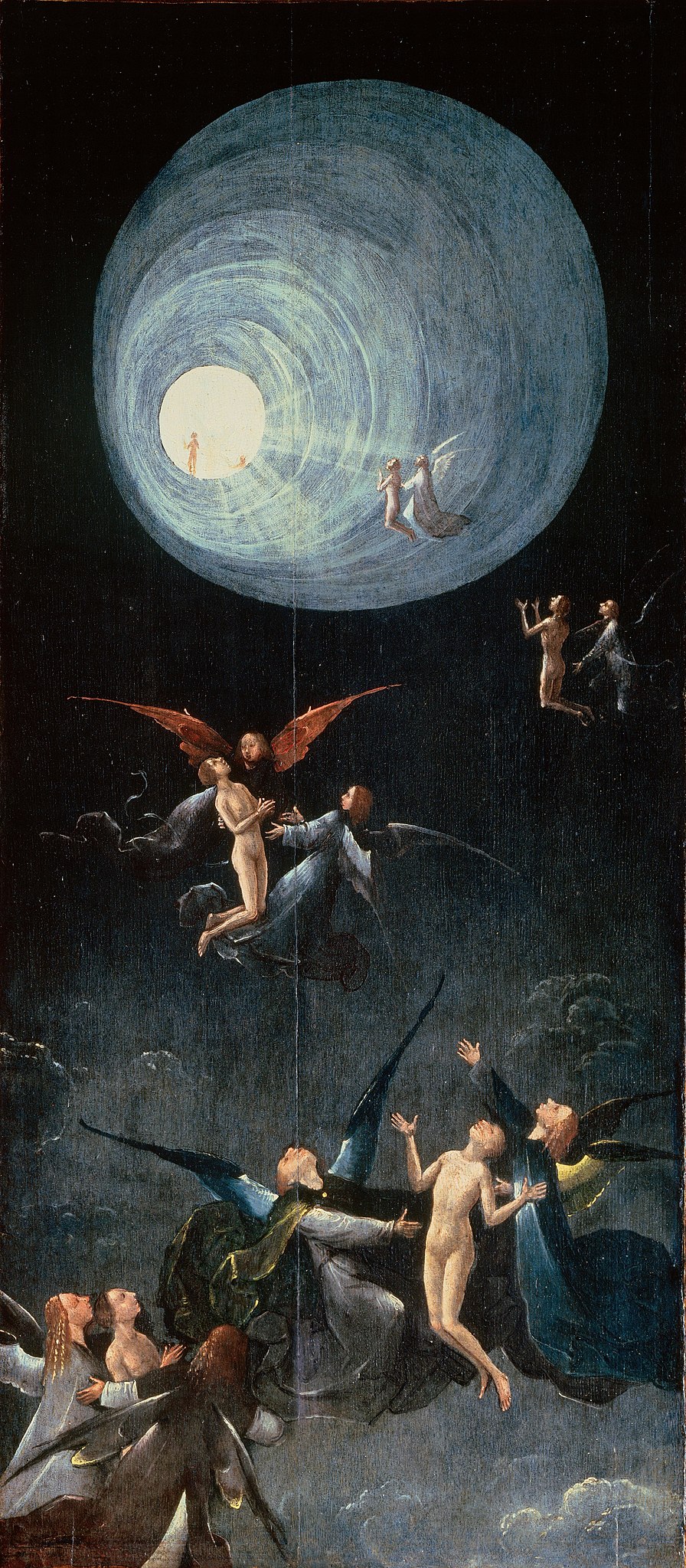The cover story of the most recent issue of Skeptical Inquirer is titled “Darkness, Tunnels, and Light – Explaining the Near-Death Experience“, written by Gerald Woerlee.  Woerlee is a physician specialising in anesthesiology, and no doubt has some extremely valid points to make regarding unconscious states, and neuromechanisms which may contribute to the Near Death Experience. However, it would certainly be worth reviewing his article to see if it does indeed ‘explain the Near-Death Experience’, as Skeptical Inquirer is so keen to tell us.
Woerlee is a physician specialising in anesthesiology, and no doubt has some extremely valid points to make regarding unconscious states, and neuromechanisms which may contribute to the Near Death Experience. However, it would certainly be worth reviewing his article to see if it does indeed ‘explain the Near-Death Experience’, as Skeptical Inquirer is so keen to tell us.
Firstly, it’s pleasing to see that Woerlee is skeptical of previous ‘explanations’ of the NDE such as Sagan’s ‘re-lived birth hypothesis’ and Susan Blackmore’s assumption of neural noise in the visual cortex providing the tunnel effect. Such reductionist ideas conveniently ignore the multiple aspects which present themselves in the NDE, and simply focus on one or two well-known ‘symptoms’ such as the tunnel experience and the bright light. They fail to address the NDE as a whole, and instead attempt to ‘debunk’ the numinous experience by finding physiological mechanisms for single parts of it.
Unfortunately, Woerlee’s hypothesis suffers from the same criticism, in that his main argument is an attempt to explain the ‘tunnel’ and ‘light’ aspects of NDEs. Not only that, but he also explicitly ignores the other aspects of the NDE even when presented to him. While Woerlee has the good sense to avoid claiming that he has solved the mystery of NDEs (despite the misleading cover headline for Skeptical Inquirer), he is still guilty of diminishing the actual experience he relates,as he picks out certain parts of this well-known anecdote while ignoring other points which argue for something much more intriguing.
The death-bed story that Woerlee quotes from is related in Chapter 2 of Sir William Barrett’s “Death-Bed Visions – The Psychical Experiences of the Dying”, published in 1926 (the work was actually uncompleted at the time of Barrett’s death, but was nevertheless subsequently published, and has since become an early classic on death-bed apparitions). The title of this chapter will give the first hint that Woerlee has ignored some important aspects in this anecdote, as it is headed “Visions seen by the Dying of Persons by them Unknown to be Dead”.
In this chapter Barrett investigates so-called “Peak-in-Darien” experiences, where a person near death reports seeing a recently deceased person of whose death they were unaware of at that time. The story told is of a woman named ‘Mrs B.’ (also referred to as ‘Doris’), who had given birth to a baby despite the fact that she was dying from heart failure herself. This story was passed on to Barrett by his wife, who was the attending obstetrician. He then investigated further and gathered testimony from others present during this time.
Woerlee relates details from this testimony which serve his purpose. This is what he takes from the testimony of the Matron:
A matron was also present, and reported: “Her husband was leaning over her and speaking to her, when pushing him aside she said, ‘Oh, don’t hide it; it’s so beautiful.’â€
However, Barrett prefaces the Matron’s testimony (in its complete form) by saying that it is “the most important evidence” collected in his investigation. Evidence of what? The fact that Mrs. B. had a vision of her deceased sister – despite not having been told by her family that she had recently died:
I was present shortly before the death of Mrs. B., together with her husband and her mother. Her husband was leaning over her and speaking to her, when pushing him aside she said, ‘Oh, don’t hide it; it’s so beautiful.’ Then turning away from him towards me, I being on the other side of the bed, Mrs. B. said, ‘Oh, why there’s Vida,’ referring to a sister of whose death three weeks previously she had not been told. Afterwards the mother, who was present at the time, told me, as I have said, that Vida was the name of a dead sister of Mrs. B.’s, of whose illness and death she was quite ignorant, as they had carefully kept this news from Mrs. B. owing to her serious illness.
Mrs. B.’s mother gave further testimony, which agreed with Lady Barrett’s, that not only did the dying woman see her deceased sister, but also her father (however, she was well aware of the fact that he was deceased). She also told of how her daughter was confused by the fact that her deceased sister Vida had appeared with her father, describing how Mrs. B. said:
‘I can see Father; he wants me, he is so lonely.’ She spoke to her father, saying, ‘I am coming,’ turning at the same time to look at me, saying, ‘Oh, he is so near.’ On looking at the same place again, she said with rather a puzzled expression, ‘He has Vida with him.’
Beyond the fact that this anecdote contains a ‘veridical hallucination’ of identifiable individuals, it is important to note that the ‘brightness’ that Mrs. B. saw is far from being a simple visual effect. The brightness is instead something of such majesty and heavenly qualities that this mother feels she must leave her new-born baby for:
Her baby was brought for her to see. She looked at it with interest, and then said, ‘Do you think I ought to stay for baby’s sake?’ Then turning towards the vision again, she said, I can’t – I can’t stay; if you could see what I do, you would know I can’t stay.’ But she turned to her husband, who had come in, and said, ‘You won’t let baby go to anyone who won’t love him, will you?’ Then she gently pushed him to one side, saying, ‘Let me see the lovely brightness.’
Woerlee, however, summarises this complete anecdote, as told by Barrett, in the following fashion:
The optical effects of pupil widening were very likely the cause of the “bright light†and “bright forms†seen by this woman. However, to her and her family, as well as to all observers, the experiences and observations she reported while dying were not just mental and optical manifestations of a mundane biological event. Instead, they were an intense and wondrous confirmation of deeply held socio-cultural beliefs in a life after death.
It is troubling that Woerlee fails to mention the more intriguing aspects of this case, and merely refers to the visions that Mrs. B. saw as ‘bright forms’. In fact, he goes so far as to say that “this unfortunate woman interpreted the bright and blurry images of out-of-focus people elsewhere in the room as ‘bright forms.'” It is hard to say whether Woerlee read Barrett’s investigation in full, but the above comments appear disingenuous considering that Barrett himself says the visions are not likely “to have been due to…misinterpretation of some object actually present to sight – as when a dressing-gown is mistaken for a woman – for not only was there nothing in the room to suggest such an illusion, but she recognized both her deceased father and sister, moreover she was quite unaware of the death of the latter.”
In retrospect, after reading the complete details of this anecdote, is it any wonder that the woman and her family took this experience as an “intense and wondrous confirmation” of a life after death, rather than “just mental and optical manifestations of a mundane biological event”?
Greg Taylor, owner/editor of ‘The Daily Grail‘, is currently researching the mystery of whether consciousness survives the body. He welcomes enquiries from publishers, magazine editors, and literary agents who are interested in his work






